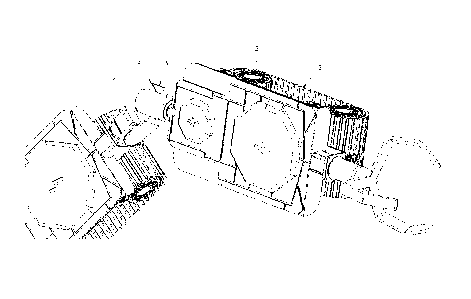Some of the information on this Web page has been provided by external sources. The Government of Canada is not responsible for the accuracy, reliability or currency of the information supplied by external sources. Users wishing to rely upon this information should consult directly with the source of the information. Content provided by external sources is not subject to official languages, privacy and accessibility requirements.
Any discrepancies in the text and image of the Claims and Abstract are due to differing posting times. Text of the Claims and Abstract are posted:
| (12) Patent Application: | (11) CA 2906857 |
|---|---|
| (54) English Title: | A HIGH MOBILITY, HIGN POWER, AND FLEXIBLE ROBOT |
| (54) French Title: | ROBOT FLEXIBLE HAUTE PUISSANCE A GRANDE MOBILITE |
| Status: | Deemed Abandoned and Beyond the Period of Reinstatement - Pending Response to Notice of Disregarded Communication |
| (51) International Patent Classification (IPC): |
|
|---|---|
| (72) Inventors : |
|
| (73) Owners : |
|
| (71) Applicants : |
|
| (74) Agent: | |
| (74) Associate agent: | |
| (45) Issued: | |
| (22) Filed Date: | 2015-10-06 |
| (41) Open to Public Inspection: | 2017-04-06 |
| Availability of licence: | N/A |
| Dedicated to the Public: | N/A |
| (25) Language of filing: | English |
| Patent Cooperation Treaty (PCT): | No |
|---|
| (30) Application Priority Data: | None |
|---|
A high mobility and high power robot, designed to be able to carry heavy packs
and payloads
over long distances on the ground, and be able to safely cross over high
walls, descend into
steep drops, cross over narrow chasms, and climb trees and other vertical
structures, using
back-drivable motors and a sectioned body shape. The limits of the robot's
mobility on the
ground depend only on its body length, which is adjustable. The power of the
robot depends on
the sizes and designs of the robot's power sources and motors, which are
adjustable.
A high mobility, high power, and flexible robot.
Background of the Invention
Field of the Invention:
The invention belongs to the field of mechatronics. An interdisciplinary field
that combines
mechanical engineering and electronic engineering. The invention shares
similarities with a
class of robots commonly referred to as unmanned ground vehicles. Unmanned
ground
vehicles (UGV) are electromechanical systems that can be either autonomous or
remotely
controlled to perform a wide variety of tasks. UGVs are generally wheeled
platforms, actuated
by motors, and carry customized tools/payloads that allow them to perform a
variety of tasks.
Unlike stationary robots, these UGV systems are mobile and can travel around
the ground.
The invention possesses a level of mobility and power beyond that of any
grounded robots or
unmanned systems currently existing. It is able to carry heavy equipment packs
and payloads
over long distances, can safely climb over high walls, descend steep drops in
terrain, cross over
narrow chasms, and even climb trees/vertical structures. A combination of
mobility and power
makes this invention unique and stand out from all other developed robotics or
unmanned
systems.
Note: Claims are shown in the official language in which they were submitted.
Note: Descriptions are shown in the official language in which they were submitted.

2024-08-01:As part of the Next Generation Patents (NGP) transition, the Canadian Patents Database (CPD) now contains a more detailed Event History, which replicates the Event Log of our new back-office solution.
Please note that "Inactive:" events refers to events no longer in use in our new back-office solution.
For a clearer understanding of the status of the application/patent presented on this page, the site Disclaimer , as well as the definitions for Patent , Event History , Maintenance Fee and Payment History should be consulted.
| Description | Date |
|---|---|
| Time Limit for Reversal Expired | 2018-10-09 |
| Application Not Reinstated by Deadline | 2018-10-09 |
| Deemed Abandoned - Failure to Respond to Maintenance Fee Notice | 2017-10-06 |
| Application Published (Open to Public Inspection) | 2017-04-06 |
| Inactive: Cover page published | 2017-04-05 |
| Inactive: IPC assigned | 2015-10-30 |
| Inactive: First IPC assigned | 2015-10-30 |
| Extension of Time to Top-up Small Entity Fees Requirements Determined Compliant | 2015-10-22 |
| Inactive: Filing certificate - No RFE (bilingual) | 2015-10-14 |
| Filing Requirements Determined Compliant | 2015-10-14 |
| Application Received - Regular National | 2015-10-09 |
| Inactive: QC images - Scanning | 2015-10-06 |
| Inactive: Pre-classification | 2015-10-06 |
| Inactive: QC images - Scanning | 2015-10-06 |
| Small Entity Declaration Determined Compliant | 2015-10-06 |
| Small Entity Declaration Determined Compliant | 2015-10-06 |
| Abandonment Date | Reason | Reinstatement Date |
|---|---|---|
| 2017-10-06 |
| Fee Type | Anniversary Year | Due Date | Paid Date |
|---|---|---|---|
| Application fee - standard | 2015-10-06 |
Note: Records showing the ownership history in alphabetical order.
| Current Owners on Record |
|---|
| LEO HOWARD |
| Past Owners on Record |
|---|
| None |